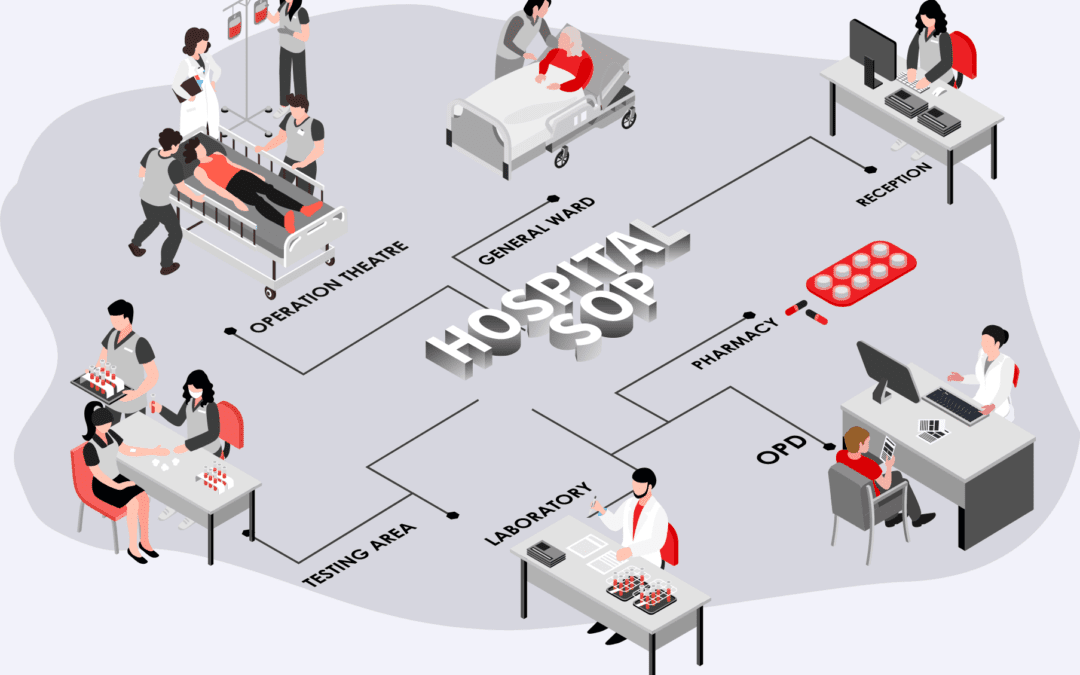Hospital administration has evolved as a specialized domain in the field of management. It involves a wide range of functions and processes which are interlinked and can get voluminous and complicated with increased services and increasing number of patients coming for consultation/treatment. How a hospital is managed on a day-to-day basis has a direct bearing on its core service which is medical care. If its processes, operations and activities are not streamlined and documented, the ability of a hospital to render effective and timely services may be adversely affected. The absence of process approach and SOPs will also hamper the functioning of a hospital as an organization. Developing standard operating procedures (SOPs) has become a necessity for hospital management and administration.
Clinical Functions
A hospital has to perform clinical functions round the clock 365 days in a year to ensure that its patients get the best possible professional medical care. Normally, the clinical functions of a hospital include OPD services (Out Patient Department), Emergency services, O.T services (Operation Theatre), Inpatient services, ICU and CCU services, nursing services etc. In order to deliver these services, a hospital administration has to ensure availability of doctors, nurses, medicines and medical supplies, medical instruments and accessories, ambulances, advanced medical care systems, blood bank, diagnostic laboratories and so on. Access to these resources heavily relies on the working of the support functions in the hospital.
For example, the medicines and medical supplies required in the Inpatient department have to be procured from the hospital pharmacy. But the pharmacy can make these requirements available only when they have it in stock or get it procured from the central store. The central store or the inventory department needs to maintain the stocks at the required levels all the time. If the medicines or supplies are not available even in the hospital inventory, these have to be procured from the outside.
For the clinical function of a hospital to run smoothly, it has to be aptly supported by other departments like inventory, logistics, finance and purchase, IT/ERP, HR and so on. The reliability of these support functions depends on the efficacy of the processes involved in them. Each process comprises of several operations and activities. These activities have to follow a step-by-step procedure to ensure that there are no lapses, standards of performance are maintained and the process output is delivered as defined and expected. This is exactly what SOPs can deliver – documented step-by-step acceptable working procedures.
For the clinical function of a hospital to run smoothly, it has to be aptly supported by other departments like inventory, logistics, finance and purchase, IT/ERP, HR and so on. The reliability of these support functions depends on the efficacy of the processes involved in them
Hospital Administration
On one hand, there is the clinical side and on the other, there is the administrative side. A hospital will not be able to deliver its core service of medical care if it does not exist and managed as a professional organization. To be functional as an organization, a hospital has to carry out crucial organizational functions like HR, finance, inventory, safety and quality, facilities management, marketing and so on; each of which further comprises of several processes. For example, just like in any other organization, salary processing or payroll management is a vital HR process in hospitals too. But hospitals usually have more employees than a regular small or medium sized business. That leaves HR department in hospitals with a monumental task of salary processing at the end of every month. Several factors have to be considered before preparing the salary of each employee. This list can include attendance, leaves and nature of leaves availed, leaves encashed, statutory deductions, basic salary, TA/DA, insurance cover, dearness allowance or any other component of CTC. With process specific SOPs in place, HR staff can execute the salary processing by following the laid down step-by-step standard procedures. SOP development and implementation can significantly reduce the chances of errors and mistakes (especially when handling a large amount of data) and ensure delivery of process output on time – error-free salary in this case.
A hospital will not be able to deliver its core service of medical care if it does not exist and managed as a professional organization
Inventory Management
In order to render effective clinical or medical services, hospitals need to keep all the necessary medical supplies ready and available all the time. And according to the services rendered, a hospital has to maintain its medical inventory. Inventory management in a hospital can be quite a heavy-duty task. Along with maintaining a wide range of medical supplies at the required levels all the time, the inventory staff also has to ensure that these supplies remain in the right storage environment all the time. Any lapse or deviation from the laid down standards of availability or storage, may cause damage to the medical supplies and render them ineffective for medical use.To ensure that the right stock levels of the medical supplies are consistently maintained, inventory department has to liaison with purchase and finance department. Inventory department has to consider the time lag between placing an indent and supplies reaching the inventory for stock replenishment. To ensure that the storage environment is consistently maintained, inventory staff has to coordinate with IT, power, vendors and suppliers for the technicalities and repair and maintenance of storage facilities. Thus, inventory management in hospitals involves managerial, technical and technological processes. It becomes essential for hospital administration to equip its inventory department with SOP procedures.Inventory SOPs will help hospital employees to systematically carry out the supply-chain activities in a step-by-step manner to make sure that procurement, storage, maintenance and availability of medical supplies is done as per the required standards.
Inventory SOPs will help hospital employees to systematically carry out the supply-chain activities in a step-by- step manner to make sure that procurement, storage, maintenance and availability of medical supplies is done as per the required standards.
Statutory Obligations
Although statutory norms may vary from place to place usually hospitals have to remain in compliance with a fairly long list of statutory obligations as made necessary by the applicable regulatory framework. Safety and quality are two important and sensitive areas for hospitals and are fairly and squarely uncompromisable. Any degree of departure from the laid down standards of safety and quality in a hospital may attract serious regulatory actions against such hospitals.
SOP procedures or SOPs can play a helpful role with respect to adherence to statutory obligations in hospitals. Laying down a step-by-step procedure for executing operations and activities can help ensure that there are no deviations from the established standards in the flow of work at any stage. The statutory standards can be incorporated in the SOPs.
The statutory standards can be incorporated in the SOPs.
Billing and Payment Systems
Fewer organizations have to handle billing and payments on such a scale and frequency as most hospitals do. Payments in a hospital are generated from multiple sources like registration fees, OPD consultation fees, patient discharge bills, purchase of medicines and supplies, clearance of periodic bills and so on. Secondly, dues are also accumulated for the inpatients on account of medicines, other medical supplies, diagnosis and other clinical services provided to them by the medical staff. This gives rise to a voluminous quantum of billing and payments in hospitals originating from different sources of services. This also gives rise to the necessity to carefully and systematically prepare the bills or execute the bill generation process. SOP development can prove to be immensely helpful for hospitals in bill generation and payment processes. By following a systematic step-by-step procedure, finance staff can gather information from various departments about the primary and supportive clinical services rendered to the patients and prepare the bill as per the applicable rules of the hospital. Bill generation and payment process involve obtaining official clearances and approvals from the concerned hospital authorities.
By following a systematic step-by step procedure, finance staff can gather information from various departments about the primary and supportive clinical services rendered to the patients and prepare the bill as per the applicable rules of the hospital
SOP development and implementation can help hospitals ensure that their clinical and organizational functions are effectively and efficiently carried out and that there is no lapses or negligence in discharge of duties so that high standards of professional medical care can be provided to patients. By providing medical care services, hospitals play a vital role in the human society. This makes it even more important for hospitals to assume the shape, structure and design of an organization and to be managed professionally.
To read more about SOPs, click here SOP, ERP & SOP Integration, Why do most enterprises don’t benefit from SOPs? and SOP Validation.
Benefits of Standard Operating Procedures (SOPs)
YRC is an “Expert Service Division” of Mind-A-Mend Consultancy Pvt. Ltd.
YRC Related Articles: How to Write SOPs for Marketing?, 6 Ways To Grow Your Business, How to Start a Retail Business in India, Business Expansion Plan for Small Entrepreneurs, Six Steps to Writing a Great SOP for Retail, How to write SOPs for an Apparel Brand?, How to Develop SOPs for Quick Service Restaurant?, How to write SOPs for Furniture Showroom
Author Bio











